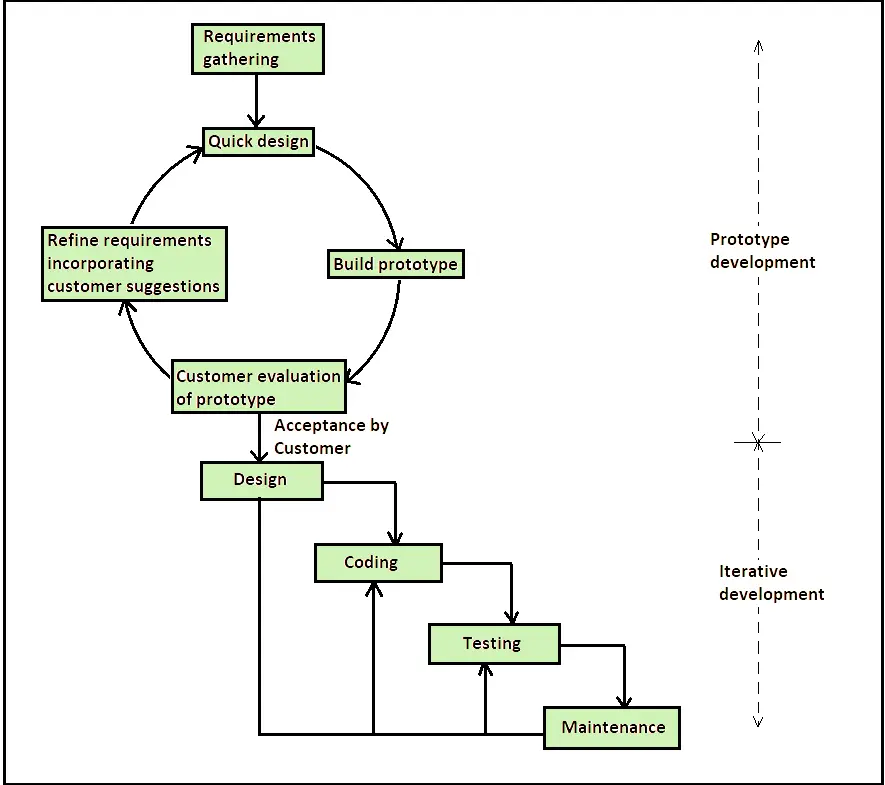The Prototype Model is an iterative software development process that involves creating an initial version of a software system, which is then refined through a series of iterations. This model is often used when the requirements for the system are unclear, or when stakeholders have difficulty articulating their needs. The Prototype Model allows developers to quickly create and demonstrate a working version of the software, which can be evaluated by stakeholders and used to refine the requirements.
This model can be particularly useful for developing user interfaces or other aspects of a software system that require feedback from users to refine the design. Overall, the Prototype Model can help to improve the quality of the final software system by allowing for early and continuous feedback from stakeholders.

Steps Involve in SDLC Prototype Model
The Prototype Model is an iterative approach to software development that involves creating a prototype, or early version, of the software to gather feedback and refine the final product. The steps involved in the Prototype Model are:
- Requirement Gathering and Analysis: The first step is to gather requirements and analyze them to understand what features and functions the software should have.
- Quick Decision: Once the requirements are understood, the development team can make quick decisions about which features to prioritize and include in the prototype.
- Build a Prototype: The prototype is then developed quickly and with minimal documentation, focusing on the core features and functions.
- Assessment or User Evaluation: The prototype is then assessed and evaluated by users or stakeholders to gather feedback and identify areas for improvement.
- Prototype Refinement: Based on the feedback gathered, the prototype is refined and improved to better meet the requirements and expectations.
- Engineer Product: Finally, the refined prototype is used as the basis for engineering the final product, with further development, testing, and documentation as necessary.
Advantages of Prototype Model in Software Engineering
- Reduces the risk of incorrect user requirements: The Prototype Model involves creating a working model of the software product, which helps in identifying incorrect user requirements at an early stage of the development process.
- Supports early product marketing: The prototype can be used to demonstrate the software product to potential customers, which helps in early product marketing.
- Good for projects with changing or uncommitted requirements: This model is ideal for projects where the requirements are changing or uncommitted, as it allows for flexibility and adaptability to the changing needs of the project.
- Allows for user feedback: The Prototype Model allows for user feedback, which helps in refining the software product and making it more user-friendly.
- Provides regular and visible progress: The Prototype Model allows for regular and visible progress, which aids in project management and helps to ensure that the project is moving in the right direction.
- Reduces maintenance costs: Errors can be detected and corrected at an early stage of development, which reduces the cost of maintenance and bug fixing in the later stages.
- Provides early detection of errors: As the system is made side by side, errors can be detected much earlier in the development process, which helps in reducing the cost and effort required for fixing them later on.
Disadvantages of Prototyping Model
- Unstable or poorly implemented prototypes may end up becoming the final product, leading to issues in functionality and usability.
- The model requires extensive collaboration with the customer, which can be time-consuming and costly for the customer.
- Without proper requirements analysis, design, and customer evaluation and feedback, it is easy to fall back into fixing code without addressing the root issue.
- The customer must be committed to the project for it to succeed, which can be a challenge for some customers.
- If the customer withdraws from the project, it can be difficult to finish the prototype or the product.
- Prototyping tools can be expensive, requiring significant investment.
- Building a prototype may require specialized tools and techniques, adding to the complexity of the process.
- The process of creating a prototype can be time-consuming, which may not be feasible for some projects with tight timelines.
- Prototypes may be too specific to a customer’s needs and not have a broad market appeal.
- It is challenging to predict how long the project will take to complete due to the iterative nature of the model.
Follow tutorials.freshersnow.com to get instant updates regarding the SDLC Prototype Model and also we urge you to follow our portal to get information about Software Engineering.
